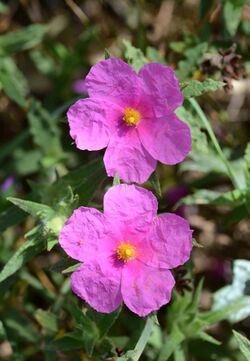Biology:Cistus crispus
| Cistus crispus | |
|---|---|

| |
| Scientific classification | |
| Kingdom: | Plantae |
| Clade: | Tracheophytes |
| Clade: | Angiosperms |
| Clade: | Eudicots |
| Clade: | Rosids |
| Order: | Malvales |
| Family: | Cistaceae |
| Genus: | Cistus |
| Species: | C. crispus
|
| Binomial name | |
| Cistus crispus | |
Cistus crispus is a shrubby species of flowering plant in the family Cistaceae , with pink to purple flowers, native to south-western Europe and western north Africa.
Description
Cistus crispus grows up to 50 cm (1 ft 8 in) tall. Its grey-green leaves are wavy (undulate), oblong to elliptical in shape, usually 1–4 cm (0.4–1.6 in) long by 4–15 mm (0.2–0.6 in) wide. They have three prominent veins and are covered a mixture of short stellate hairs and longer simple hairs. The flowers are arranged in few-flowered cymes, each flower being 3–4 cm (1.2–1.6 in) across with five purplish-red petals and five hair-covered sepals.[2]
Taxonomy
Cistus crispus was first described by Carl Linnaeus in 1753 in Species Plantarum (p. 524).[1] The specific epithet crispus means "curly" or "finely waved", referring to the leaves.[3]
It hybridizes with Cistus albidus to form the hybrid Cistus × incanus.[4]
Phylogeny
A 2011 molecular phylogenetic study placed C. crispus as the deepest branching member of the clade of purple and pink flowered Cistus species (the "purple pink clade" or PPC).[5]
| Species-level cladogram of Cistus species. |
| Species-level cladogram of Cistus species, based on plastid and nuclear DNA sequences.[4][6][5][7] |
Distribution
Cistus crispus is native to north Africa[6] and south-western Europe, including Portugal, Spain , France , Corsica, Italy and Sicily.[2]
References
- ↑ 1.0 1.1 "Cistus crispus", The Plant List, http://www.theplantlist.org/tpl1.1/record/kew-2723349, retrieved 2015-03-02
- ↑ 2.0 2.1 Warburg, E.F. (1968), "Cistus albidus", in Tutin, T.G.; Heywood, V.H.; Burges, N.A. et al., Flora Europaea, Volume 2: Rosaceae to Umbelliferae, Cambridge University Press, pp. 283, ISBN 978-0-521-06662-4
- ↑ Coombes, Allen J. (1994), Dictionary of Plant Names, London: Hamlyn Books, ISBN 978-0-600-58187-1, p. 42
- ↑ 4.0 4.1 Guzmán, B.; Vargas, P. (2005), "Systematics, character evolution, and biogeography of Cistus L. (Cistaceae) based on ITS, trnL-trnF, and matK sequences", Molecular Phylogenetics and Evolution 37 (3): 644–660, doi:10.1016/j.ympev.2005.04.026, PMID 16055353
- ↑ 5.0 5.1 Civeyrel, Laure; Leclercq, Julie; Demoly, Jean-Pierre; Agnan, Yannick; Quèbre, Nicolas; Pélissier, Céline; Otto, Thierry (2011), "Molecular systematics, character evolution, and pollen morphology of Cistus and Halimium (Cistaceae)", Plant Systematics and Evolution 295 (1–4): 23–54, doi:10.1007/s00606-011-0458-7
- ↑ 6.0 6.1 Guzman, B.; Lledo, M.D.; Vargas, P. (2009). "Adaptive Radiation in Mediterranean Cistus (Cistaceae)". PLOS ONE 4 (7): e6362. doi:10.1371/journal.pone.0006362. PMID 19668338. Bibcode: 2009PLoSO...4.6362G.
- ↑ Guzmán, B.; Vargas, P. (2009). "Historical biogeography and character evolution of Cistaceae (Malvales) based on analysis of plastid rbcL and trnL-trnF sequences". Organisms Diversity & Evolution 9 (2): 83–99. doi:10.1016/j.ode.2009.01.001.
External links
- Page, R.G. (n.d.), Cistus crispus L., archived from the original on 2015-04-02, https://web.archive.org/web/20150402111354/http://www.cistuspage.org.uk//Cistus%20crispus.htm, retrieved 2015-03-09
Wikidata ☰ Q5770408 entry
 |

